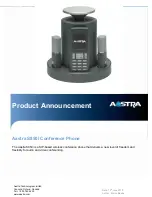
10
Power Grade
Range
5~19 5~19 0~15 0~15
Max Power
33dBm 33dBm 30dBm 30dBm
Power Grade
Difference
2dBm 2dBm 2dBm 2dBm
5.4
:
Identity
:
If user want to connect to network, GSM need affirm users’ legality identity. Users’ identity information
recorded in SIM. According to these information, network affirm user’s validity. Important Digital Identification
used in GSM include:
1. IMSI
(
International Mobile Subscriber Identification
)
This number is the exclusive number to indicate user’s identity. When user enter network, the system find
user’s information according to this number. It is composed by three parts:
MCC
(
Mobile Country Code
)
Country Number, three digits, indicate user’s country.
MNC
(
Mobile Network Code
)
Mobile Network, two digits, indicate Network Operator.
MSIN
(
Mobile Subscriber Identification Number
)
User Identity Number, eleven digits, indicate Mobile
Subscriber in network.
2. TMSI
(
Temporary Mobile Subscriber Identification
)
To safeties, we use TMSI instead of IMSI when
transmitted IMSI, TMSI is valid only in local area. Its structure is selected by manage department, and the
whole size is not more than 4 bits.
3. IMEI
(
International Mobile Equipment Identity
)
exclusive number, system also can distinguish validity of
equipment by this number.
5.5
:
GSM Voice Path
:
There needs to be some way to encode the voice into data
Next the data must have error protection added to it
The Data has further error protection
It is modulated
It is bursted
Again, this is very simplistic and other steps will be explored during this section.
5.6
:
logical channels
TCH
:
Mobiles on a call use a Traffic Channel (TCH). The TCH is a two way channel used to exchange
speech information between the mobile and base-station.
SACCH
:
When the MS is on a call, it is constantly monitoring the Received Signal Quality (a bit error rate
measurement known as RxQual) and the Received Signal Level (a power measurement call RxLev). These
are constantly being sent back to the BS on a Slow Associated Control Channel (SACCH).
FACCH
:
The Fast Associated Control Channel is used to pass critical information to the mobile during a
call, by taking over the TCH from the callers.
BCH
:
All BTS produce a Broadcast Channel (BCH). The BCH is like a lighthouse or beacon. It's on all the
time and allows mobile to find the GSM network. The network for a variety of user functions also uses the BCH
signal strength. It's a useful way of telling which is the closest BTS to the mobile. It also has information coded
onto it, such as the identity of the network (e.g. Mannesmann, Detecon, or Optus), paging messages for any
mobiles needing to accept a phone call, and a variety of other information. Each mobile will monitor the power
of adjacent cell BCH’s to aid the network in making hand-off decisions.
FCH
:
Frequency Correction Channel
SCH
:
Synchronization Channel
BCCH
:
Broadcast Control Channel
CCCH
:
Common Control Channel
The base-station posts a PCH (paging channel) on the CCCH part of the BCH. When the mobile receives the
PCH, it responds by sending a RACH. The remainder of the process is identical to the mobile originated case.
AGCH:Access Grant Channel
RACH:Random Access Channel, When the mobile sends out a RACH, to start a call, to avoid collisions
with bursts in adjacent TS, RACH bursts, that are shorter than normal are sent.
The Stand-Alone Dedicated Control Channel (SDCCH) is used during call set up as a stepping stone to
the Traffic Channel. It is also used to pass signaling when the mobile is in IDLE mode. This is used for example
for SMS Point-to-Point messages as well as Location Updates that we will look at later.
Содержание W420
Страница 1: ...Voxtel Repair Manual Item W420 ...
Страница 23: ...23 3 LDO circuit ...
Страница 24: ...24 Cameramodule control circuit ...











































